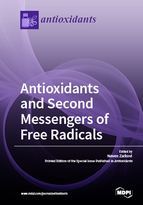Antioxidants and Second Messengers of Free Radicals
A special issue of Antioxidants (ISSN 2076-3921).
Deadline for manuscript submissions: closed (30 June 2018) | Viewed by 72653
Special Issue Editor
Interests: oxidative stress; growth regulation; cancer; lipid peroxidation; 4-hydroxynonenal (HNE)
Special Issues, Collections and Topics in MDPI journals
Special Issue Information
Dear Colleagues,
While research on pathology of oxidative stress has been complemented in recent years by intense studies on redox signaling, there is a lack of general understanding of pathophysiological roles played by reactive aldehydes like malondialdehyde, 4-hydroxynonenal, 4-hydroxyhexenal, acrolein, etc., which are considered also as “second messengers of free radicals”. Being generated mostly by lipid peroxidation, they often form bioactive adducts with macromolecules important for pathophysiology of living cells, thus mimicking the effects of ROS even in the absence of severe oxidative stress. We lack especially understanding on the complex effects of antioxidants that might be active in regulation of toxic and/or hormetic effects of reactive aldehydes.
Therefore, this Special Issue will publish original research papers and reviews on complex aspects of reactive aldehydes and their macromolecular adducts (especially with proteins and nucleic acids) generated during lipid peroxidation and their interference with natural and synthetic antioxidants in physiology of cell and in pathophysiology of various diseases studied by modern bioanalytical methods applied in translational and clinical medicine.
Prof. Dr. Neven ZarkovicGuest Editor
Manuscript Submission Information
Manuscripts should be submitted online at www.mdpi.com by registering and logging in to this website. Once you are registered, click here to go to the submission form. Manuscripts can be submitted until the deadline. All submissions that pass pre-check are peer-reviewed. Accepted papers will be published continuously in the journal (as soon as accepted) and will be listed together on the special issue website. Research articles, review articles as well as short communications are invited. For planned papers, a title and short abstract (about 100 words) can be sent to the Editorial Office for announcement on this website.
Submitted manuscripts should not have been published previously, nor be under consideration for publication elsewhere (except conference proceedings papers). All manuscripts are thoroughly refereed through a single-blind peer-review process. A guide for authors and other relevant information for submission of manuscripts is available on the Instructions for Authors page. Antioxidants is an international peer-reviewed open access monthly journal published by MDPI.
Please visit the Instructions for Authors page before submitting a manuscript. The Article Processing Charge (APC) for publication in this open access journal is 2900 CHF (Swiss Francs). Submitted papers should be well formatted and use good English. Authors may use MDPI's English editing service prior to publication or during author revisions.
Keywords
- Reactive aldehydes
- Advanced lipoxidation end products (ALEs)
- Lipid peroxidation
- Stress and age-associated disorders
- Metabolomics/lipidomics
- Bioactive antioxidants







